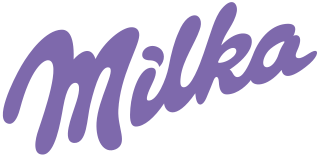
A chocolate bar or candy bar is a confection containing chocolate, which may also contain layerings or mixtures that include nuts, fruit, caramel, nougat, and wafers. A flat, easily breakable, chocolate bar is also called a tablet. In some varieties of English and food labeling standards, the term chocolate bar is reserved for bars of solid chocolate, with candy bar used for products with additional ingredients.

Pralines are confections containing nuts – usually almonds, pecans and hazelnuts – and sugar. Cream is a common third ingredient.

Toblerone is a Swiss chocolate brand owned by Mondelez International. Produced in Bern, Switzerland, sometimes manufactured elsewhere in the past, and planned to be made in Slovakia from the end of 2023. Toblerone is known for its distinctive shape, a series of joined triangular prisms and lettering engraved in the chocolate.

Ritter Sport is a brand of chocolate bar from the family-owned Alfred Ritter GmbH & Co. KG, which has its headquarters in Waldenbuch, Germany.

Milka is a Swiss brand of chocolate confectionery, originally made in Switzerland in 1901 by Suchard. It has then been produced in Lörrach, Germany from 1901. Since 2012 it has been owned by US-based company Mondelez International, when it started following the steps of its predecessor Kraft Foods Inc., which had taken over the brand in 1990. It is sold in bars and a number of novelty shapes for Easter and Christmas. Products with the Milka brand also include chocolate-covered cookies and biscuits.

Chokito is a combination chocolate bar brand, created and owned by Nestlé. The original bar consists of an ingot-shaped caramel fudge center, with a coating of milk chocolate and crisped rice on the outside. It is manufactured by Nestlé in Switzerland, Brazil, and Australia.

Swiss chocolate is chocolate produced in Switzerland. While cacao beans and other ingredients such as sugar cane originate from outside Switzerland, the actual production of the chocolate must take place in Switzerland. Switzerland's chocolates have earned an international reputation for high quality with many famous international chocolate brands.

Cailler is a Swiss chocolate brand and production factory based in Broc. It was founded in Vevey by François-Louis Cailler in 1819 and remained independent until the early 20th century, when it associated with other producers. Shortly before, Cailler opened its main factory at Broc in 1898. The company was finally bought by Nestlé in 1929 and became a brand. Cailler is the oldest chocolate brand still in existence in Switzerland.

Gianduia or gianduja is a homogeneous blend of chocolate with 30% hazelnut paste, invented in Turin during Napoleon's regency (1796–1814). It can be consumed in the form of bars or as a filling for chocolates.

Guylian is a Belgian chocolate brand and manufacturer best known for its seashell shaped pralines. The company was founded in 1958 in Sint-Niklaas, Belgium by Guy Foubert and is now owned by the South Korean company Lotte Confectionery.

Chocolat Frey AG, commonly Frey, based in Buchs in the Swiss Canton of Aargau, manufactures chocolate and chewing gum. The products of the leading chocolate manufacturer on the Swiss chocolate market are sold both in Switzerland and abroad under the brand name of Frey as well as additional private labels. The company, founded in 1887, is a business enterprise of the M-Industry and has been a part of the Migros Group since 1950.

Belgian chocolate is chocolate produced in Belgium. A major industry since the 19th century, today it forms an important part of the nation's economy and culture.

Villars Maître Chocolatier SA is a Swiss chocolate company founded in 1901 and based in the city of Fribourg. The building in which the company has been in since 1901 is one of national importance and a Swiss cultural heritage asset. The company is noted for its success in selling to tourists, owing to a number of unique products including chocolates with an unusually high percentage of nuts and almonds and 72% cocoa dark chocolate napolitains.
Chocolats Halba is a Swiss chocolate producer based in Pratteln (Basel-Landschaft). Chocolate Halba operates its own factory shops, the so-called Schoggihüsli, in Pratteln and at the former factory in Hinwil. It is a division of the retail company Coop and processes around 20,000 tons of chocolate into bars, pralines and Easter bunnies every year. Around 40% of the chocolate is delivered to the Coop Group, the rest goes to third-party customers around the world – including those in Switzerland, Germany, France, Holland, the USA, Canada, New Zealand and China. In addition to the Coop brand Swiss Confisa, they also produce for other brands such as "Die Gute Schokolade" by Plant-for-the-Planet and for the processing industry.
Chocolat Jacques is a Belgian firm which was founded in 1896 by Antoine Jacques (1858-1929) in Verviers. Production was later moved to Bruges and Eupen in the east of Belgium, where its headquarters were also located since 1923.
Alprose is a Swiss chocolate producer based in Caslano (Ticino). It was founded in 1957 under the name Titlis SA and received its current name in 1983.

Kägi Söhne AG is a Swiss confectioner and chocolate producer based in Lichtensteig. The chocolate-covered wafer specialty Kägi fret from the eastern region in Switzerland, Toggenburg, are available in various flavours and are manufactured by Kägi Söhne AG, Toggenburgerwaffeln- & Biscuitfabrik.
Chocolat Kohler was a chocolate producer based in Lausanne, founded in 1830 by the Kohler brothers. It is currently a brand owned by Nestlé.
















